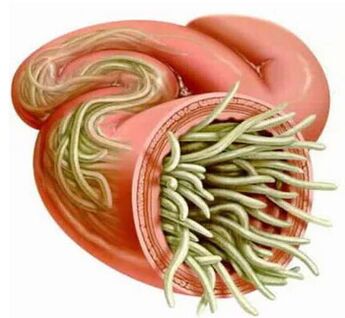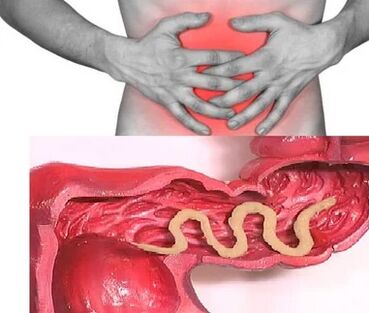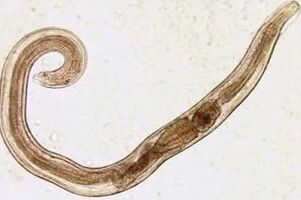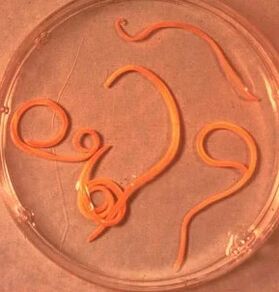To date, science is known about 280 types of worms that can grow and live in the human body, parasites in various organs and tissues.The frequency of human infections depends on the climate and socio-economic conditions of certain territories (in less developed countries, especially located in the tropical and subtropical zones, the level of parasitic infection is much higher than that of developed countries).
Methods of human infection with helminths:
- Biogelmintosis (animal infection).
- Contagioine helminthoses (sent from person to person).
- Geogelmintoses (a disease caused by parasites that run one of the important cycles on Earth).

Factors affecting manifestation of helminthiases
Methods of penetration of parasites into the body:
- Helminth adjustment level to the human body;
- Population density (quantity) of individual parasites;
- Worm habitat (tissue parasites live in soft tissue thickness, and life explanations in hollow organs).Some helminths in various phases have educational and fabric forms.The larval level and the development of worms, as a rule, result in clearer pathological changes.
In the absence of re -infection, the number of adult parasites in the human body does not increase.This feature significantly distinguishes helminthic aggression from bacteria, viruses, fungi and simple organisms.
Worms in humans: symptoms
Helminthosis is a disease characterized by 2 stages of course (acute, from two weeks to two months) and chronic (from several months to several years).
Symptoms of acute phase helminthiasis
The first signs of the disease can be shown at different times (most often after 2-3 weeks, with ascaridosis-after 2-3 days, and with phylairiosis, the incubation period lasts 6-18 months).
In the level of acute parasites, the most characteristic symptoms are allergic reactions (antibodies are produced to parasitic larvae antigens).Often, itchy rash, which is exposed to recurrent courses, has an increase in recurrent courses, regional lymph nodes appear on the skin, and the occurrence of general or local edema, muscle and articular pain may occur.Also, parasite larvae can cause chest pain, cough, drowning, stool disorders, nausea and vomiting.
At the same time, the acute phase of helminthiasis can be accompanied by more serious disorders (severe forms of pneumonia, hepatitis, allergic myocarditis, hepatosterogalia (liver and spleen increase).
In the blood, the number of eosinophils (eosinophilia) increases and the normal quantitative ratio between protein fractions (disproteinemia) is disrupted.

Signs -Chronic helminthiasis
Symptoms of chronic phase directly depend on which organ is "inhabited" with parasites, as well as their size and quantity play an important role.
Therefore, when parasites in a single individual intestine, the disease can occur without symptoms (except for cases of infection with very large parasites).Characteristics -Chronic phase features of intestinal helminthiasis are dispeptic disorders.In children, acenoarotic syndrome and pain are clearer.With large invasion -ascarides, intestinal obstruction, mechanical jaundice and pancreatitis are possible.
By eating all the necessary ingredients for their important activities from the host body, helminths cause digestive disorders, violations of vitamin, minerals, carbohydrates, proteins and fats.At the same time, the product of worm life prevents normal intestinal microflora and reduces the body's immune system.
In people suffering from helminthias, due to poor immunity and enhanced cellular distribution process (due to tissue parasites), the risk of malignant tumors increases significantly.
Type of parasites helminths in the human body
The agent of human helminthiasis is 2 types of worms: round (nematodes) and flat (ribbons and plates).
Round worms
Pinworm
The parasites that cause enterobiosis are small cavity worms (up to 10mm) with white gray coloring.Infection occurs in a better way (through the mouth).The reason for this is dirty hands.Parasitic eggs can be on the ground, on infected animal feathers, vegetables and non -washable fruits, and more.The cutting larvae develops within two weeks of the digestive tract.Switch into adult individuals, parasitic worms at the bottom of the small and upper colon.

Soldier
Soldiide is a large parasite shaped in red spindle, reaching an adult 40 cm (female) and 15-25 cm (male).Without a suction cup or other setting device, ascaride can freely move towards the food mass.Eggs prescribed by female parasites are distinguished by impurities.
Acadosis infections occur if they swallow mature eggs together with water or vegetables -non -washable fruits where there is soil particles.After the eggs penetrate the intestines, the larvae cook out of them.Then, introducing it into the intestinal wall, they reached the liver according to the bloodstream, and from there they fell into the lungs.Through pulmonary alveoli, ascaride larvae through the respiratory tract penetrate the oral cavity again.After repeated swallowing, the parasite reaches the small intestine, where it develops into adults.The worm lived for 12 months, then died and stand out with stools.In the intestines of the owner can live both or a few hundred individuals.
Vlashev
Vlasov, the agent of trichocephalosis, is a white helminth in the early intestine and reaches a size of 4-5 cm.Parasites are fed by blood and rectal mucosa tissue.
The eggs are drowned by the women on the intestinal walls out together -with stools.Their developments occur in the environment (optimally in the soil).Eggs with parasitic larvae are penetrated into the body in a bad way, through dirty hands, with water or vegetables and non -washed fruits.

Trichinella
The causative agent of trichinellosis is a small round helminth that reaches 2-5 mm long.Infections occur when the use of poor fried meat (pork, pigs, forest pigs).Penetrating the intestines, parasitic larvae within 3-4 days of cooking to sexually mature conditions.The lifespan of the worm is 40 days, after which the parasite is dead.Driving the intestinal wall, the larvae penetrates the bloodstream and brought into all the organs of the human body, settling in the muscles.In this case, the respiratory and facial muscles, as well as the muscles of the limbs, are most often affected.
On the first day after the intrusion, the patient complained of stomach ache.Then, after about 2 weeks, body temperature increased to 39-40 s, itchy rash appeared on the skin, muscle aches developed, and the face swollen.During this time, in the case of large infections -there is a significant risk of death.After about a month, recovery occurs.The parasite is packed in the form of a circle, after which it dies within two years.
Ankylostoma and not -Korea
Both of these parasites are the same as biological features, as well as in the disease caused.With this, it is customary to unite them under the general name (ankylostoma).Worms reach 10-15 mm parasites in 12-P.intestines.Keep in mind that this is one of the most common, but at the same time, rarely identifies parasites.Worms penetrate the human body through the skin when in contact with the infected soil.Further, enter the bloodstream, they, like ascarides, migrate to the lungs, and then, through the bronchus, together with sputum hopping -to the digestive tract.Anquilostoma parasites in the intestine, attached to the intestinal wall.The parasites eaten exclusively by biting the blood vessels stab the mucous membranes, injecting the anti -components there.During the day, adults can absorb 0.05-0.35 ml of blood on average.Therefore, the most characteristic symptoms of this helminthiasis are iron deficiency anemia, as well as changes in protein fraction ratios (disproteinemia).
A flat worm
Tape
This is one of the largest helminths that reaches 10-20 meters long.The disease caused by this parasite is called dipillobotriosis.The worm development cycle begins with freshwater fish or crustaceans.The larvae entered the human body, which is the owner of the extensive ribbon with the infected fish caviar or fillet.Reaching the small intestine, the parasites are attached to the wall and for 20-25 days to grow into sexually mature individuals.
Bacon hepatic
The parasites that cause opisthorchiasis are flat worms that reach 7-20 mm long.It should be noted that more than 50% of cases of infection with liver plates (they are also called cat biconomaters) fall on Russians.Parasitic larvae begins to grow after the eggs fall into fresh water (from swallowed snails).Then they penetrate the fish body (Mas fish, crucian carp, bream, roach).Human infections occur when you eat infected fish meat that has not undergone adequate heat treatment.Hepatic bomb larvae from the small intestine penetrates the biliary tract and into the gall bladder, setting there with two suction cups.
Bull and pork
The parasite is almost the same in the structure of 5-6 meters.Infections with tusiarinhosis and tusiasis occur due to the use of cattle or pork infected with finns (one form of mid -helminthiasis).The visible finns, presented in the form of white bubbles, reached 0.5 cm, attached to a person's small intestinal wall and within 3 months of adult individuals.The parasite of the strip, consisting of more than 2000 segments, is constantly evolving.At the same time, the final segment containing eggs out and freely moves along the colon to the opening of the anus, and then crawls out of the anus, or stands out into the external environment together with stools.The most characteristic symptoms -Helminthiasis is a violation of the digestive tract.
Echinococcus
For this parasite, one is a mid -host.Parasitic worms in the human body in the form of finns.Echinococcus's final owner is a wolf, dog or cat.Infections occur in a better way in contact with animals and environmental objects, with a handful of echinococcus eggs.After entering the intestines, oncospheres (six larvae) develop from them.From their intestines they penetrate the bloodstream and carry throughout the body.
Alveokokk
This parasite, which is considered to be a variety of echinococcus, is the cause of one of the most dangerous helminthiases (alveococcosis), which is similar to the severity of cirrhosis and liver cancer.Infection occurs with oncospheric penetration (eggs with cooked larvae) into the intestine.There, the embryo comes out of the egg and, introducing to the intestinal wall, penetrating the bloodstream.Further, with blood flow, parasites spread through all tissues and organs (most often localized in the liver).There the main developmental stage begins on the larvae (multi -chamber bubble, laurelocyst) formed).Each space contains the parasite embryo head, which continues to grow gradually.Lavrocists are a very aggressive formation that is constantly growing due to increased bubbles, and also has the ability to sprout into the liver, such as cancer metastasis.
Diagnosis of helminthiasis
Diagnosis of helminthic invasion includes the following events:
- A comprehensive collection of anamnesis that helps to know the possible causes of infection;
- Studies of stools, blood, intestinal content 12p, rectal and perianal mucus, muscle tissue, pulmonary phlegm, bile.During the analysis, eggs, segments or parasite fragments can be detected.At the same time, increased eosinophil content in the blood is also a signal of the presence of helminthiasis.
- In the diagnosis of diseases caused by larvae or tissue parasites, serological studies (elisu, RSC, indirect aglutination, immunofluorescence analysis, etc.) were performed.
- To identify helminths that affect liver tissue, ultrasound, CT and endoscopic studies are prescribed.
Worms in humans: treatment
In the acute phase of parasite infection, patients are prescribed detoxification and desensitizing therapy.In severe diseases (liver trematodosis, trichinellosis), glucocorticoids are used according to medical signs.
As a special therapeutic drug, taking into account the nature of the pathogen, a special anthelmintic chemotherapy agent is prescribed.
In parallel, patients are recommended to take antihistamines and enterosorbents.The final stage of treatment includes the use of probiotics that normalize intestinal microflora.
Special sparing diets are also prescribed (foods should be easily digested and contain a little fat).
During the period of anthelmintic therapy, patients need strict adherence to personal hygiene (to prevent re -infection).At the same time, with many helminthiasis, all family members and people infected in continuous relationships should undergo treatment.





















